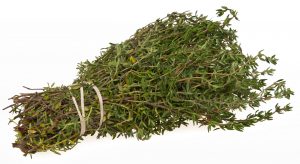How to Grow Thyme – A Guide to Growing Thyme
 I like to think of Thyme as being as vital to traditional British cuisine as tarragon is to French. It’s a versatile herb used to enhance everything from stuffings to soups and stews to omelettes and scrambled eggs.
I like to think of Thyme as being as vital to traditional British cuisine as tarragon is to French. It’s a versatile herb used to enhance everything from stuffings to soups and stews to omelettes and scrambled eggs.
There are many varieties of thyme available but they all share the virtue of being attractive to bees, easy to look after and low growing.
Thyme is very suitable for pot growing as well as in the ground. Keeping a pot on the windowsill will provide fresh thyme for use throughout the winter, when the outdoor plants are dormant
According to Culpepper, thyme is a native of India (although most authorities believe it to be originally from southern Europe) and a good remedy for many diseases from lung problems to intestinal worms and particularly useful to women delivering children. “The herb taken inwardly comforts the stomach much, and expels wind.”
Thymes are very aromatic due to them containing the essential oil Thymol which is a powerful disinfectant and therefore preservative. The thymol is probably the reason for the medicinal reputation.
The earliest references to culinary use of thyme come from the ancient Greeks but it’s fairly certain the herb was in use well before that.
Growing Thyme
Thyme can be grown from seed, but it is easier to start from a plant which are widely available.
Thyme prefers a well-drained, sandy soil and can successfully be grown in a gravel garden or even a rockery.
If growing from seed, sow anytime from late winter to early summer in a small pot. Cover the pot with a polythene bag, secured with an elastic band to retain the moisture or use a propagator and keep at around 18ºC.
Once the seedlings are large enough to handle, transplant into 8 cm (3 inch) pots and then, when ready, into the final larger pots or the soil.
Planting out from a pot can be done at any time of the year.
Feed monthly with a general purpose liquid fertilizer during the growing season if the plant seems weak.
After three years or so the plants start to get woody. Remove from their pots, or if in the ground dig up and divide the roots for new plants.
Harvesting Thyme
- Pick the leaves as and when required.
- Harvest the leaves of the evergreen varieties through the year.
Pests and Problems with Thyme
Thyme is a trouble-free herb to grow, one of those that seems to thrive best on neglect. Avoid water logging
Varieties of Thyme
- More varieties are available as plants than from seed; some are frost hardy and evergreen, others more tender.
- As well as common thyme, there is a lemon thyme and various other scents, including camphor thyme, alpine (or basil) thyme and orange. In fact there are over thirty varieties of thyme available in the UK
Eating & Storing Thyme
A versatile herb, enhancing soups, stews, stuffings and egg dishes.
Thyme dries easily and stores well if kept in air-tight jars, Thyme also freezes well.
Companion Plant: Grow close to cabbages, cauliflower, broccoli and brussels sprouts as it is a great deterrent of cabbage root-fly or cabbage worm



